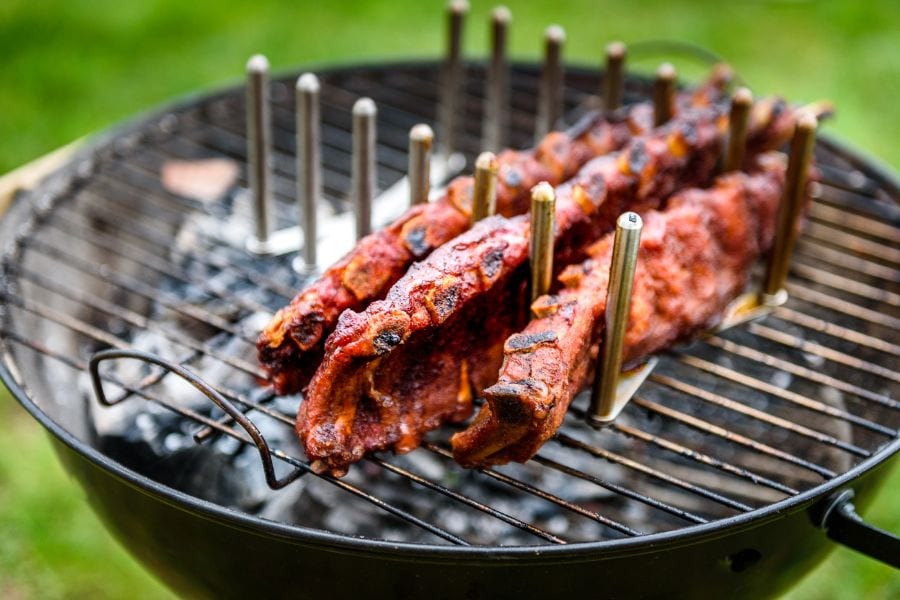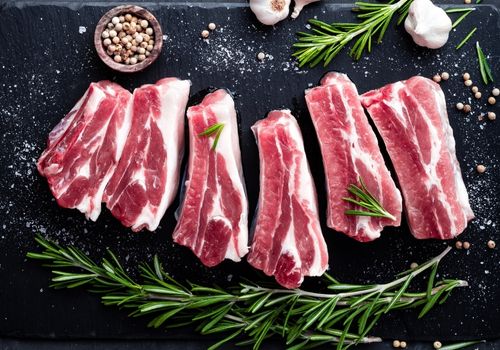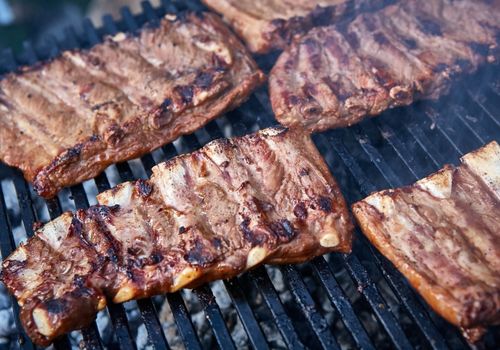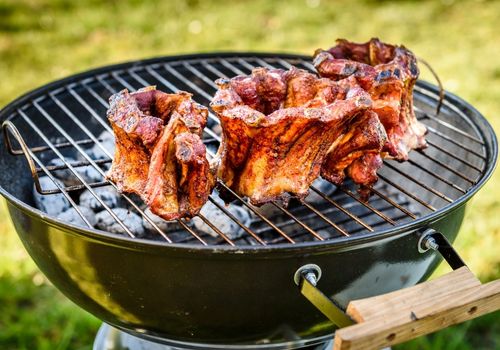Smoking pork ribs on a Weber grill can take some getting used to, particularly when it comes to managing the temperature inside the cooking chamber.
I was staying with some friends for a few days when they begged me to smoke some ribs for them. The problem was, they only had a Weber kettle. Now, I am more of a pellet grill kind of girl, so it did take me some trial and error to figure things out. Finally, though, I got it!
In this post, I am going to show you how to smoke ribs on the Weber kettle and provide you with the guidelines to do it right!

Here are step by step instructions to prepare both spare ribs as well as baby back ribs on a Weber charcoal grill:
Figure out how many coals or briquettes you need for the charcoal grill.
Then, take a chimney starter and place a wad of newspaper at the bottom. Pile in as much charcoal as you need for the grill.
Place the starter on the grill grate. Light the paper and wait until some of the coals begin to turn to ash.
Empty the charcoal starter, making sure to pile all the lit coals on one side of the grill. This will be the direct heat zone. The other side will be the indirect low heat zone.
Place a drip pan or water pan on the indirect side. This will catch any drippings, reducing the mess that you have to clean up.
The best temperature for smoking spare or baby back ribs in the first half is 180 F. With a charcoal grill, you have to set the temperature with the help of the vents on the grill.
Move the bottom vent so that it is half closed. Next, close the top vent almost the entire way.
Close the lid and monitor the lid thermometer. When it hits 180 F, your ribs are ready to go in the grill.
Add the wood chips or chunks onto the coals and close the lid. Allow the wood to start smoking.
Baby back ribs and spare ribs are covered in a thin, tough membrane. Not only is this membrane inedible, but it can also prevent the smoke flavor from really getting into the meat on the ribs.
As such, it needs to be removed.
Place the rack of ribs in front of you.
Then use a butter knife or a sharp knife to lift the membrane from one edge of the rack. Once you have managed to lift up a good section, grasp this area with a paper towel. Then, pull up slowly and remove the membrane from the entire rack.
Repeat this with the other rack as well. Discard the membrane.
In a bowl, add the yellow mustard, two tablespoons of apple juice, and Worcestershire sauce. Stir well.
In a separate bowl, add all the ingredients to the dry rub. Combine well.

Apply a thin layer of the mustard mix to each side of both racks of ribs.
Then, sprinkle a generous amount of dry rub onto each side. Press into the surface of the ribs.
Place the ribs on the cooking grate. Make sure to arrange the racks so that they are on the indirect side.
Close the lid.
If you are smoking baby back ribs, then cook the ribs for 2 hours. If you are cooking spare ribs, cook for 3 hours.
When smoking ribs on the Weber kettle, it can take some time to learn how to manage the smoking temperature.
Keep the bottom vent as it is. However, if you would like to increase the temperature, open the top vent. If you would prefer to lower the temperature instead, then close the top vent.
Once the pork ribs have cooked for either 2 or 3 hours, take them out of the smoker.
Tear off two sheets of heavy duty aluminum foil for each rack. Each aluminum foil sheet should be around twice the length of the rack of ribs.
Place the ribs on the foil. Sprinkle the brown sugar on top. Then, add the honey and the apple juice.
Wrap the ribs tightly and create a tight seal at the seams.
While wrapping the ribs, increase the temperature of the smoker.
Open the top vent a little bit and wait until the lid thermometer reads 225 F.
Place the spare or baby back ribs back in the Weber kettle.
For both spare and baby back ribs, cook ribs for 2 hours.
Take the ribs out of the smoker. Remove from the foil packet.
Apply barbecue sauce in a thin layer to either side of the pork ribs.
Place the spare or baby back ribs on the grill.
Smoke the ribs for another hour.
Pick up the ribs in the middle using a pair of tongs. Give the ribs a little bounce. If the ends start to droop and a crack starts appearing in the middle, then the ribs are done.
Take the smoked ribs out of the grill.
Let the smoked ribs rest.
Rest the smoked baby back ribs for 10 minutes and rest the spare ribs for 15 minutes.
Then serve with a side of barbecue sauce.

There are actually two rules to follow when it comes to pork ribs.
If you are cooking smaller ribs like baby back ribs, then you have to follow the 2 2 1 method. On the other hand, if you are smoking meatier woods, then you should use the 3 2 1 method.
So, what are these methods and how do they work?
Well, as ribs, especially baby back ribs don’t have much meat on the bones, you can’t really use a meat thermometer to track the internal temperature of the ribs.
This is why pitmasters have developed a way of tracking the cooking process through time.
With meatier ribs, you smoke the ribs for 3 hours, unwrapped. Then, you wrap the ribs and cook them for two hours. After this, you take them out of the wrapping, and then cook them for another hour.
In total, these ribs are smoked for 6 hours.
Now, baby back ribs don’t have as much meat which means that they are at higher risk of drying out. Due to this, they have to be cooked for 2 hours unwrapped. Then, you wrap the ribs and cook for another 2 hours. Finally, you unwrap the baby back ribs and cook for an hour.
In all, you smoke these ribs for 5 hours.
Related Reading
As the Weber kettle is fairly small, you may only be able to fit a single rack of ribs in it. I do suggest getting the additional charcoal grate so that you can stack more ribs in the grill.
If you want perfectly smoked baby back ribs, then these are the guidelines that you should be following:
About an hour before you want to smoke the ribs, take them out of the refrigerator. This gives them the opportunity to get a little closer to room temperature.
As a result, the ribs cook at a more even rate.
While a lot of people think that it is all about the BBQ sauce when it comes to smoked baby back ribs, this isn’t the case at all. The dry rub plays an important role here.
I have tried a few different combinations but the dry rub in this recipe is my favorite. It has just the right amount of sweetness and spiciness and strikes the perfect balance.
As you will have noticed from above, I have laid out instruction on how to use a chimney starter. This is so that you don’t have to use lighter fluid.
The problem with the fluid is that the smell seems to seep into everything, including the food. So, the starter is the perfect way to avoid it.
Sure, it can take a minute to get a hang of. Once you do, though, you are going to love using it to get your grill going.

When it comes to a Weber kettle, wood chunks are the best option. They burn slow and release a good amount of smoke too.
It is important to consider your options carefully here, though. Due to the mild nature of pork ribs, I have found that apple wood is the best option. Maple and pecan can be winners too. Hickory and mesquite are just a bit too strong and can over power the natural flavor of the ribs.
Whatever you do, though, don’t soak the wood before you smoke it! This is simply going to cause the wood to steam instead of smoke and can ruin the cook.
A lot of people imagine that learning how to set and alter the temperature with a Weber kettle is a daunting task. However, this isn’t the case at all. It just takes some practice.
If you aren’t too comfortable with your Weber kettle yet, I would suggest testing out how to control the temperature ahead of time. It can be a bit risky to learn things on the fly and there is a chance that you may end up ruining your ribs too.
So, add a small amount of charcoal. Then, move the bottommost vent so that it is half closed. As I mentioned, this doesn’t need to change during the cook.
The only vent that you do have to manipulate is the top one. To increase the temperature, open it further. To lower the temp, close it more.
By experimenting ahead of time, you will be able to figure out the perfect positioning for the temperature that you want.
There is no denying that using the Weber Kettle is a rather old fashioned way of making smoked ribs. Due to this, it is important to keep an eye on the lid thermometer.
In fact, if I were you, I would invest in another hood thermometer just to guarantee that you are getting the right reading for the grill.
By keeping an eye on the temp, you will be able to see if the temperature is fluctuating too much. In turn, you will be able to change the positioning of the vents to counteract this.
This can seem like such a simple thing but you would be surprised by how many people are tempted to check on their smoking meat! I get it but it is best to keep the lid closed or you risk fluctuating temperatures inside the cooking chamber.
Learning how to make smoked baby back ribs or spare ribs on this kind of Weber kettle is definitely worth it. All you have to do is follow the instructions here and you will be able to figure it out in no time at all!